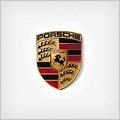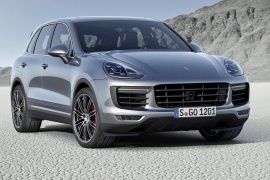
PORSCHE Cayenne Turbo
Generations Timeline, Specs and Pictures

In 2017, the third generation of the Porsche Cayenne was unveiled at the Frankfurt Motor Show.
Its top model was the Cayenne Turbo, with 550 hp under the hood.
The third generation came to fix what its predecessor was criticized for: the exterior design. While the second generation featured some details that could remind of a Hyundai, the third generation was completely new from tip to toe.
On the outside, there was four LED for the running lights incorporated into the headlights. The actual shape of the headlights was inspired by the 918 supercars. For the Turbo version, there was a different bumper with a lower splitter and a very wide grille that visually made the car look wider. Not like it wasn’t wide enough. From the side, some subtle sculptured doors and fenders helped the car’s aerodynamic. In the rear, a roof-spoiler incorporated the third stop-light. The rectangular exhaust pipes were peaking on both sides of the rear diffuser.
Inside, there was a mixed feeling about the car, with some elements typical for a sports car and some others for an SUV. On the three-spoke steering wheel, there was a rotary knob for the driving settings from comfort mode to sports. The instrument cluster was a mix between analog and digital. The tachometer was analog, but on the sides, it featured TFT displays for navigation and vehicle settings. On the main infotainment screen, there was the navigation system and the audio. It featured only Apple CarPlay connectivity.
Under the hood, the Cayenne Turbo featured a 4.0-liter V8 unit with two turbochargers. It was mated as standard to an eight-speed automatic transmission.

The Cayenne Turbo facelift was introduced in 2014 and it was an enhanced version of the non-facelifted version.
It offered the same torque as the non-facelifted Cayenne Turbo S, but less power.
When it was introduced in 2002, the Cayenne Turbo offered 450 hp and it was considered one of the best sport-SUV on the market. It was offered with an off-road package as well. Over time, since the customers were not interested in that option, it was deleted from the list.
The exterior of the 2014 Cayenne was enhanced with a sharper design and clear lines. The front fenders, the grille, and the headlights were entirely new, with LED for daytime running lights and, for the Turbo version, full-LED. The grille was still divided into three main areas, with the biggest one kept for the engine. The underbody aluminum shield was replaced by a black plastic one. In the back, the roof-spoiler became a standard fit for the entire range.
Inside, the connection with the 911 range was more obvious due to the five-dials instrument cluster and the centrally-mounted tachometer. The new, tall and slim, air-vents were inspired by the Panamera sedan, but on the center console, the buttons from the PTM system were an updated version of those found in the first generation Cayenne.
Under the hood, the revised engine offered 20 hp more than its predecessor. It was the same twin-turbo 4.8-liter V8 unit and it was paired to an 8-speed Tiptronic (automatic) transmission, with manual override to select gears. For the suspension, while the rest of the range was offered with steel-suspension fitted as standard, the Turbo version featured the upgraded version with air bellows.

The second generation of the Porsche Cayenne was launched at the 2010 Geneva Motor Show.
It was a big improvement over its predecessor and featured an evolved design.
The first generation of the Cayenne brought as many fans as enemies to the German Porsche brand, but the fact was that it became the most sold vehicle from the brand’s stable. Not only that the SUV trend was good for business, but it also offered true performances and comfort. It was the absolute Porsche for the entire family.
The second generation came with a lighter bodywork and new styling for the front, that resembled the Panamera. The hood was similar to the 4-door Porsche sedan as well. The big debate about the car was in the rear, where the taillights were somehow similar in the design concept with those from a Hyundai SantaFe but for the Turbo version, the big four-round exhausts with a deep sound changed the perspective.
Inside, the Panamera inspiration was obvious. A new steering wheel, instrument cluster, and buttons layout on the center console was installed. The center stack was redesigned as well and the vents were taller than the VW-like air-vents from its predecessor. The sunroof was standard.
For the engine, the Cayenne Turbo featured a 4.8-liter V8 unit which offered 500 hp. For the transmission, the 2010 Cayenne lost the low-range transfer case. The standard transmission was an 8-speed Tiptronic gearbox. All-wheel drive was installed standard as well. Other new improvements led to a decrease in the overall weight by 180 kg (400 lbs). Thanks to the new technologies, the Cayenne Turbo was 23% more fuel-efficient than its predecessor.

The facelift for the first generation of the Cayenne was introduced in 2007 and, as expected, a Turbo version was on the table as well.
After the first shock passed and the market understood that a Porsche SUV might be one of the best ideas to save the famous German sports-car brand, the critics started to lower their voices and customers started to order more. It was the perfect Porsche for a family, an excellent SUV, and an awarded off-road vehicle. Moreover, between the launch of the Cayenne and the facelift, almost 160.000 units were sold. It was a huge success.
For the 2007 facelift, the German car-manufacturer listened to its customers and got rid of the Porsche 996-inspired headlights. The new ones featured a clear lens over the lamps and they were re-shaped. A new, vertical, daytime running light appeared on the outer side of the side-scoops and the center grille was smaller. The Cayenne Turbo rode on 18” light-alloy wheels. It was fitted as standard with PASM (Porsche Active Suspension Management) and air suspension.
The interior was almost unchanged when compared with its non-facelifted version. It featured the same seats and standard audio system. It received new colors for the leather seats. The Cayenne was fitted with a power-liftgate as an option.
The Cayenne Turbo was fitted with a direct-fuel injection system and VarioCam (variable valve timing). The bi-turbo engine offered a better fuel-efficiency than before also due to the longer transmission ratio, which allowed the engine to run at lower rpm than before. For the all-wheel-drive system, the Porsche Traction Management (PTM) was enhanced to offer better traction in all conditions.

As in the 911 range, the Turbo was the top of the line version for the Cayenne.
It was introduced at the same time with the rest of the range and it offered Porsche performances in an SUV-form.
It was inconceivable for a Porsche fan to accept an SUV from the famous sports-car manufacturer. But the car was needed. The German brand needed a car to sell in volumes and save them from a foreseeable financial collapse. The Cayenne Turbo managed to satisfy the customers who were looking for a performance vehicle in an SUV shape.
The exterior look was inspired by the 911, with headlights that resembled those installed on the 911 - 996 version. The front bumper was tall and crossed by no less than four grilles, either for the look or to cool the engine. As any SUV on the market, the Cayenne featured a tall greenhouse, which was somehow unusual for the Porsche brand. The Turbo version was designed to be the sportiest version for the medium-sized SUV. In the back, a quad exhaust system was installed and an aluminum shield was seen under the bumper.
Inside, the gear-selector was carried-over from 911. The instrument panel featured two large round dials with a central multi-functional display. A tall center console separated the front passengers. The power-adjustable leather front seats were accompanied by the rear leather bench, which featured a split-backseat to extend the trunk space. The Cayenne S featured a Bose sound system with 14 speakers. A Porsche Communication Management (PCM) infotainment unit with navigation and a backup camera was available.
Under the hood, the Cayenne Turbo was fitted with a turbocharged 4.5-liter V8 unit mated to a standard 6-speed automatic. Thanks to the standard air-suspension, the Turbo version could get up to 28 cm (11”) of ground clearance.























































